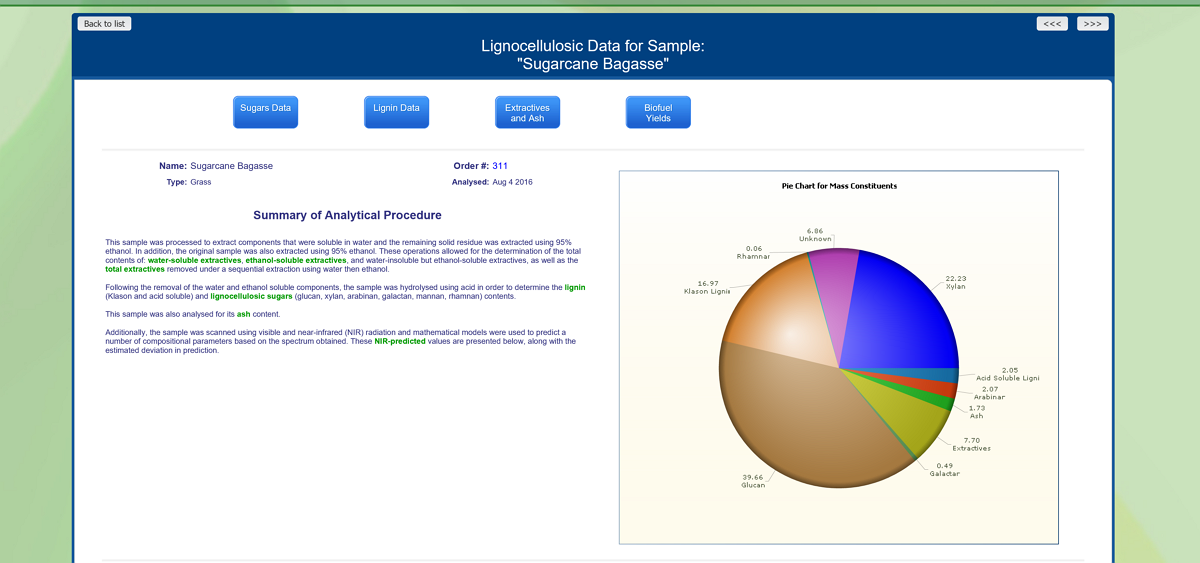Analysis to Maximise the Efficiency of Anaerobic Digestion
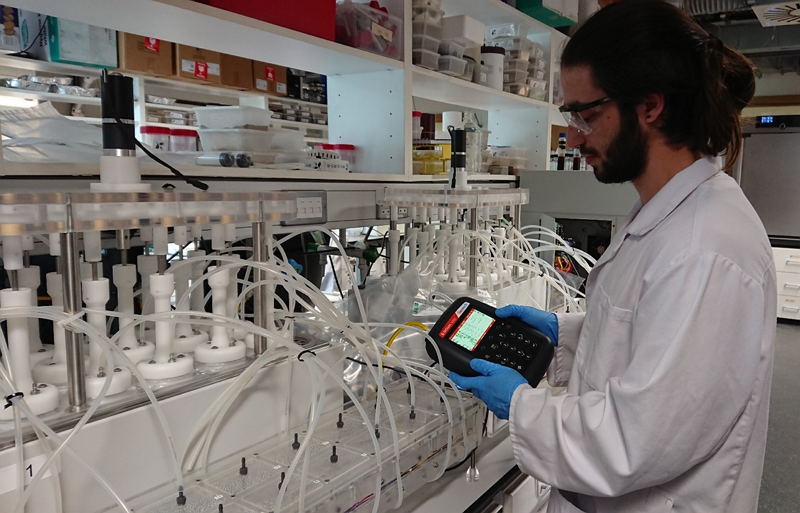
Table of Contents
Background to Anaerobic Digestion
For the past few decades, waste management has become one of the major challenges across the world. Waste disposal has been strictly regulated by governments in order to reduce soil, water, and air pollution caused as a result of landfilling and the direct disposal of wastes to water. Anaerobic digestion (AD) has been touted as a means of dealing with organic wastes while, at the same time, also addressing mankind’s energy needs. The process involves biogas production via the microbial degradation of organic compounds in the absence of oxygen. AD reduces the bulk of organic matter to be disposed, generates digestate rich in nutrients that can be of agricultural value, and produces biogas rich in methane which can be used as fuel directly or can be converted to compressed natural gas (CNG) and liquefied natural gas (LNG).

AD has a long history, with the first operational AD system constructed in India in 1897. Currently, there are a number of countries that each have thousands of biogas plants for domestic and commercial purposes. It is considered that the simplicity of AD, when compared against other biological and thermal technologies for the processing of organic wastes, coupled with its adaptability to a wide spectrum of feedstocks, that has led to its current scale of adoption. Crop and livestock farmers use AD plants for fuel production, manure management, and fertiliser production, whilst commercial AD plants can operate with a more diverse set of feedstocks, including municipal solid wastes (MSW) and industrial effluents, and their focus can often be on the reduction of chemical oxygen demand (COD) and effluent treatment as well as on energy generation.
Advantages of Anaerobic Digestion
There are a number of advantages of using AD processes, however the two most important ones relate to the reduction/treatment of waste and to the valorisation of feedstocks.
Waste Treatment through AD
Both aerobic and anaerobic digestion degrade the organic matter present in the waste, but aerobic digestion is limited by oxygen supply and utilisation rate by microbes. The major advantages of the anaerobic process with regards to waste treatment relate to the fact that less sludge is retained after the process compared with aerobic digestion (so reducing residue treatment costs) and that AD allows for the possibility of higher organic loading rates. In most cases, AD also reduces the chemical oxygen demand (COD) of the waste stream significantly and it has also been noted that toxic compounds can be converted to their non-toxic forms by the process.

Disposing waste in open landfills can generate intense odours due to the formation of volatile malodorous compounds and can also contaminate the soil, water, and air with pathogens. AD can be used as a means for odour and pathogen reduction, depending on the operating conditions. It can convert the volatile compounds to methane and carbon dioxide, however poorly-managed AD facilities can result in the accumulation of volatiles, exacerbating odour problems. The efficacy of AD in pathogen removal depends on the process conditions and exposure time. Thermophilic digesters are best at removing pathogens from the waste, with mesophilic digestors taking longer to reduce pathogen levels. However, digesters operating at psychrophilic/ambient conditions may still have pathogens surviving at the end of the process.

Valorisation of Feedstocks through Anaerobic Digestion
Biogas as an Energy Source
AD produces biogas as a result of its degradation of organic matter. Biogas composition is mainly methane (CH4, 50-70%)
and carbon dioxide (CO2, 25-50%), with the remainder being nitrogen (N2),
hydrogen (H2), oxygen (O2), and traces of
hydrogen sulphide (H2S) and
ammonia (NH3).

The energy content (lower heating value, LHV) of methane is 35.8 MJ/m3, and the LHV of biogas as a whole can range from 21.3 to 23.4 MJ/m3, depending on its methane content. Biogas is commonly used in combined heat and power (CHP) processes to produce heat and electricity. Depending on the digester type and the climate of the region in which the AD facility is located, some or all of the heat produced may be used within the plant to maintain the digester temperature at optimum levels. Biogas can also be upgraded to biomethane for the production of compressed natural gas (CNG) and liquefied natural gas (LNG), which have similar energy properties as fossil-fuel natural gas and can be used as transportation fuels. It is estimated that 1172 m3 of methane is equivalent to 1 tonne of oil equivalent.

Digestate as a Saleable Product
Digestate is the residual matter left after the AD process. Nutrients are preserved in the digestate during AD meaning that it can be rich in macronutrients such as nitrogen, phosphorous, and potassium, as well as in micronutrients. Hence, it can have value in being applied to the soil as a fertiliser. Additionally, the fibre in the solid residues of digestate can help to build up the humus content in the soil which is advantageous for soils of a low carbon content. Digestate can also improve a number of physical parameters of the soil, such as available water capacity, workability and drainage. In selling the digestate to local farmers as a fertiliser, AD facility operators can increase their revenues from the process, whilst farmers can at the same time make significant savings in using nutrient rich digestate as opposed to more-costly mineral fertilisers. The Anaerobic Digestion and Bioresources Association (ADBA) stated that "one tonne of artificial fertiliser replaced with one tonne of biofertilser saves 1 tonne of oil, 108 tonnes of water and 1 tonne of carbon dioxide emissions".

Digestate also has other potential applications other than as a soil amendment. The fibre from the digestate can be valorised in a wide variety of means,
including uses as animal bedding, in fuel pellets, as a construction material, and as a feedstock for the production of high-value biobased products.
Biochemical Steps in the AD Process
The quality of the biogas and digestate are highly dependent on the balance of the four stages in the AD process, namely: hydrolysis, acidogenesis, acetogenesis and methanogenesis. The biochemical reactions that take place during these four stages are governed by the microbial community in the AD reactor, with the products and co-products formed at each stage having an effect on prior and subsequent stages. This means that a balanced microbial consortium of hydrolysing bacteria, acidogenic bacteria, acetogens and methanogens are required in the system. Similarly, the composition of the feedstock, or mixture of feedstocks, in the AD system, will impact upon the progression and efficiencies of each of the four stages.

In the first stage, hydrolysis, complex carbohydrates, proteins, and fats are hydrolysed to sugars, amino acids, and fatty acids, respectively. These monomers are then converted to volatile fatty acids (VFAs), alcohols, and gases in the second stage (acidogenesis). The concentration of VFAs has a significant effect on methanogenesis and is one of the key process indicators. In the third stage, acetogenesis, acids and alcohols are converted to acetic acid, hydrogen, carbon dioxide and other gases. In fourth and final stage, methanognesis, hydrogenotrophic methanogens utilise hydrogen and carbon dioxide or formate to produce methane whilst acetoclastic methanogens produce methane from acetate produced in the second and third stages.
In well-managed AD systems, all four stages are perfectly synchronised, for example with VFAs concentrations kept under control by active methanogenic bacteria. However, higher rates of acid formation compared to methane production will result in the accumulation of acids over time and lead to digester failure, a phenomenon known as “acid crash”. This situation generally occurs when there are high concentrations of easily-degradable sugars in the feedstock. Other problems may arise when there is a lot of nitrogen in the feedstock as this can result in high concentrations of ammonia, which is toxic for methanogens, being produced in the third stage (acetogenesis).
Feedstocks for Anaerobic Digestion
AD can be used to produce biogas and energy from a variety of organic feedstocks and also as a means of treatment and value-addition for various kinds of waste streams. The type of feedstock used is of great importance as it will influence the optimal AD process conditions as well as the quality of the biogas and digestate. AD facilities that rely on a small subset of agricultural residues and energy crops and on-site AD facilities that deal with the outputs of a particular industrial process tend to have relatively consistent supplies of reasonably homogeneous feedstocks. However, stand-alone AD plants that use feedstocks from a variety of sources tend to have inconsistent levels of supply as well as heterogeneous feedstock compositions that can cover wide ranges of levels in: complex carbohydrates, proteins, lipids, sugars, and acids.
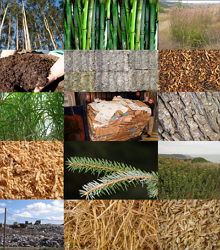
Additionally, the storage of feedstock can have a big influence in its conversion in AD processes. Improperly-stored feedstock degrades in the storage area and generates acids and ammonia which
can be toxic for AD above certain concentrations.
The properties of many feedstocks can be improved through pre-treatment prior to AD. This can involve: screening/sorting; size reduction by blending/milling; thermal treatment; and liquifaction, among other processes.
The properties of many feedstocks can be improved through pre-treatment prior to AD. This can involve: screening/sorting; size reduction by blending/milling; thermal treatment; and liquifaction, among other processes.
Analytical Requirements in Evaluating AD Feedstocks
Feedstock analysis is crucial in order to properly evaluate feedstocks for use in AD processes. Of particular importance is the biomethane potential (BMP). This laboratory tests involves mixing the organic substrate with an anaerobic inoculum in a closed reactor that is incubated at a set temperature, with the contents mixed, for a set period of time. During this period the sample is digested and biogas is produced. The volume of biogas is monitored allowing for a cumulative plot of biogas production over time to be derived. This biogas can then be analysed for its composition, in particular the methane content, to allow the BMP to be determined. The BMP can be considered to be the experimental theoretical maximum amount of methane produced from a feedstock.

In addition to the BMP, it is important to understand the composition of the organic matter in the feedstock in order to determine optimal process conditions for its digestion. For example, differentiating between: structural sugars and soluble sugars, total proteins, and total fats will help to understand how the feedstock will progress across the 4 stages of AD. Nitrogen content is also particularly important, in order to balance the C/N ratio and avoid toxic levels of ammonia, and it is often the case that, based on the results of analysis, the co-digestion of two or more feedstocks may be necessary in order to balance the carbon-nitrogen ratio (C/N) in the AD system.
Other important parameters that should be tested for in a feedstock include toxic compounds such as acids, ammonia, and heavy metals. In the case of waste streams from industries, other specific compounds/intermediates released in trace quantities by the industrial process should also be determined as they can possibly accumulate in the digester with time and might inhibit the AD process.
It should also be considered that the composition of a given feedstock is not necessarily static, it can change according to variations in its supply and production. For example, the compositions of many samples can vary according to the time of year they are harvested/collected as well as depending on their length of time in storage. As a result, samples should be tested, for their composition and BMP, in a variety of conditions, where these may be considered to influence the outputs and course of digestion in AD processes.
Analyses to Monitor AD Plant Operations
In order to achieve maximal biogas yields from a feedstock, key chemical and physical parameters should be monitored. These can be divided in to process parameters and process indicators. Process parameters include: quantity and composition of feedstock; total solids (TS); volatile solids (VS); BMP; NH4-N; organic loading rate (OLR); temperature; pH; mixing; and hydraulic retention time. Key process indicators are: total biogas yield; biogas composition; volatile fatty acids (VFAs); Alkalinity ratio (FOS/TAC); and redox potential.
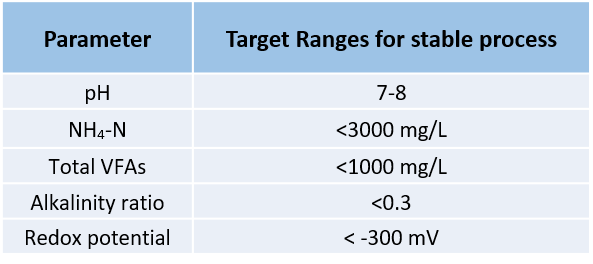
The biogas plant operator should routinely check process parameters and indicators. Temperature, pH, biogas composition,
and mixing should be checked twice a day, with TS, VS, and organic loading rate monitored once a day.
Changes of feedstock type, organic loading rate and hydraulic retention time (HRT, a measure of the average length of time the liquid/soluble compound remains in AD reactor) and
solid retention time (SRT, similar to HRT but for solid compounds) should be undertaken gradually in order to allowing microbes to adapt
to the new conditions. During this shift in conditions, any changes taking place in the biogas composition, pH, and VFAs concentration should be
closely and frequently monitored in order to predict and pre-empt failures in the AD process. The VFAs and alkalinity ratio for a stable digester should be tested twice a month. However, more frequent testing
is warranted in cases where digester instability results from changes in feedstock type and supply.
Analyses and Methods to Help Improve AD Process Efficiencies
The efficiency of the AD process can be tested by performing simple mass balances based on the composition of the feedstock and its volatile solids content coupled with the same set of analyses on the digestate. An efficient biogas plant will maximise the digestion of organic matter and its conversion to methane, resulting in minimal amounts of organic material in the digestate. However, in many cases AD facilities do not fully digest the feedstock, typically as a result of high organic loading rates and low hydraulic retention times. It is often warranted that the digestate is tested for its residual biogas potential (RBP) in order to determine how efficiently the feedstock has been digested. The RBP is a lab-based test, based on the BMP test, that takes digestate as the starting material and determines how much biogas can be produced from its digestion in controlled conditions. Any biogas and biomethane produced in the RBP tests can be considered to be lost potential yields from the previous digestion of the sample in the AD system.
AD efficiencies can also be reduced when organic matter is converted to carbon dioxide rather than methane. This phenomenon can be avoided by increasing the concentration of methanogens in the AD reactor either by augmenting with a high-methane producing inoculum source or by providing feedstock and process conditions that can enrich methanogens concentrations.
Co-digestion with nutrient and pH complimenting feedstocks is one of the several ways to improve the process efficiency. However, the fine-tuning of the co-feed ratio of different feedstocks for co-digestion, organic loading rate, and hydraulic retention time optimisation will be dependent on the particular feedstocks being considered. The figure below shows the percentage of methane in the biogas and how it varies according to the relative proportions by which fruit waste is co-fed with two different feedstocks (anatomicals from slaughter house waste and blood). It can be seen that the optimum ratio varies substantially according to which co-feed feedstock is used.

Other approaches to improve process efficiencies and yields include: the use of chemical agents to balance nutrients and pH; allowing for an adaptation of the microbial inoculum to the unfavourable process conditions (e.g. via a long start-up phase); and the supplementation of enzymes to increase reaction rates.
Analytical Requirements for Digestate
The digestate output from anaerobic digestion contains high volumes of water and can be treated by a variety of methods including: drying, ammonia stripping and drying, biological treatment, and reverse osmosis. The liquid and solids fractions of the digestate can be separated in a number of ways, but typically mechanical separation is used. The separated solids can be either composted or dried and pelletised, although composting is not necessary if the final application of the digestate is for land-spreading.
Before using digestate for any applications, it should be tested for fibre content, fibre composition, chemical oxygen demand (COD), biological oxygen demand (BOD), NH4-N, nitrogen-phosphorous-potassium (NPK), micronutrients, trace elements, heavy metals, microbial load and pathogens.
How Celignis Can Help with Your Analytical Requirements for AD
Celignis is an analytical laboratory focused on the bioeconomy. We have developed a strong reputation for detailed and accurate analysis of lignocellulosic biomass and of the intermediates and outputs of biorefining processes, having analysed thousands of samples in this sector. We have recently expanded our suite of analysis packages to cover properties relevant to the anaerobic digestion sector. These methods are based on the expertise of new employee Lalitha Gotttumukkala who has worked for several years on determining properties relevant for AD and on optimising AD processes. With the user-friendly online Celignis Database you can monitor the results from our analyses even while the analysis is still ongoing. Our team of experts are also just a call/email away to discuss your results and provide advice.
Listed below are some of the analytical services we provide for evaluating AD feedstocks and processes:
Stoichiometric Methane Potential (SMP)
The maxmium theoretical methane potential possible from a given feedstock would be attained under conditions where all of the organic material of the sample was converted to biogas, with no residual digestate produced. We calculate this stoichiometric methane potential (SMP) using the Buswell Equation which uses the stoichiometric ratio of the products methane, carbon dioxide, ammmonia and hydrogen sulphide under the assumption that these are the only products from the complete breakdown of biomass of chemical composition of CHONS. The SMP is determined whenever analysis packages that involve the ultimate analysis (CHNS and ash) of a sample are undertaken.
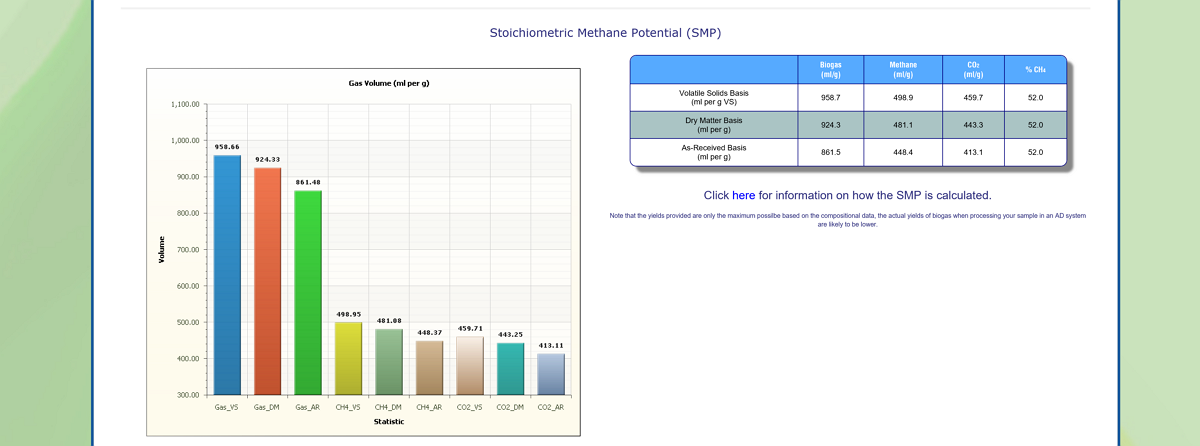
Biomethane Potential (BMP)
Of course, the actual biomethane outputs of anaerobic digestion will always be less than the theoretical maximum calculated by the SMP as some of the biomass will be converted into microbial matter and also because it is unlikely that all of the organic matter (e.g. the lignin) will be fully converted. We therefore recommend that the biomethane potential (BMP) test is undertaken in order to get a better approximation of yields from a real AD system. We have two Anaero BMP systems that allow us to digest your samples and determine the biogas yield over the course of the digestion which can last for 14, 21, 18, or 40 days. Our BMP analysis packages also determine the total solids (TS) and volatile solids (VS) contents of the sample and also involve periodic analyses of the composition of the biogas (for methane, carbon dioxide, hydrogen sulphide, oxygen, and ammonia) using the Biogas 5000 portable gas analyser.
AD Feedstock Analysis
Our analysis package P93 - Feedstock Chemical and Biological Analysis covers the important chemical and biological properties of the feedstock. Analytes that we determine include: Total Solids, Volatile Solids , pH, Chemical Oxygen Demand (COD), Biological Oxygen Demand (BOD), Phosphorus, Potassium, Ammonia, Carbon, Hydrogen, Nitrogen and Sulphur.
Digestate Analysis
Analysis package P94 - Digestate Chemical and Biological Analysis covers the same analytes as the AD Feedstock Analysis Package (P93) but for the digestate. We also have Deluxe versions of our BMP analysis packages that include all of the analytes in our AD Feedstock and Digestate Analysis packages.
Residual Biogas Potential (RBP)
We can also undertake residual biogas potential (RBP) analysis on the digestate from AD facilities in order to determine the BMP and biogas yields from this residue. This test can be undertaken for 14 or 21 days and the Deluxe version of these analysis packages also includes all analytes listed in the Digestate Analysis package.
Detailed Compositional Analysis of the Feedstock and Digestate
Using our expertise in the lignocellulosic analysis of biomass samples, we can offer an even more comprehensive profile of the chemical composition of both the feedstock and digestate. Under analysis package P10 we can determine the amount of extractives, lignin (Klason and acid soluble), ash, and lignocellulosic sugars (glucan, xylan, mannan, arabinan, galactan, and rhamnan) in the feedstock and digestate. Analysis package P12 can analyse the water extractives for soluble sugars, package P14 can determine the starch content of samples, and package P15 can quantify the amounts of five different uronic acids that are present. When such detailed analysis is undertaken on both the feedstock and the digestate (whether from the AD facility itself or from our BMP tests) it is possible to get a detailed picture regarding how each of the main biogenic polymers (cellulose, hemicellulose, lignin, and starch) are digested in the AD process. These observations can lead to process improvements targeted at maximizing biogas yields from components (cellulose, hemicellulose, and starch) that should be digested in efficiently-operating AD systems.
